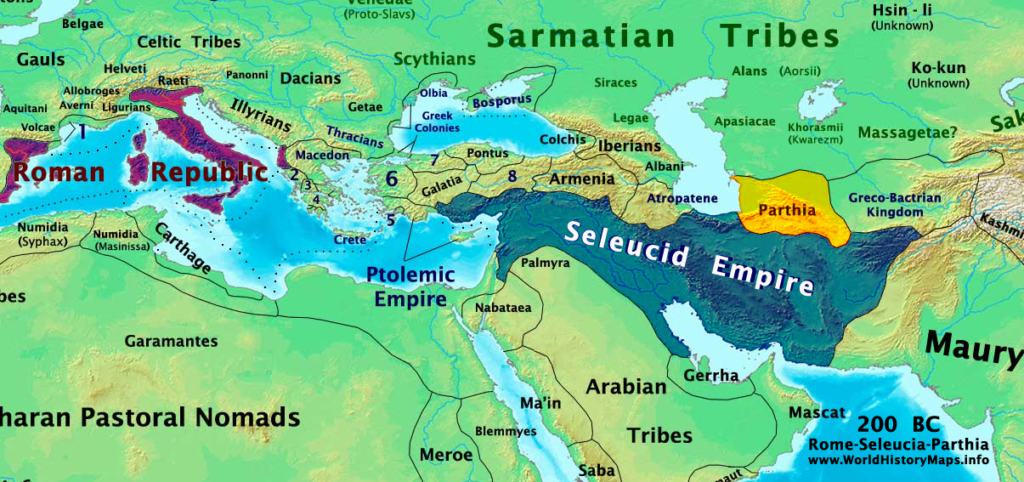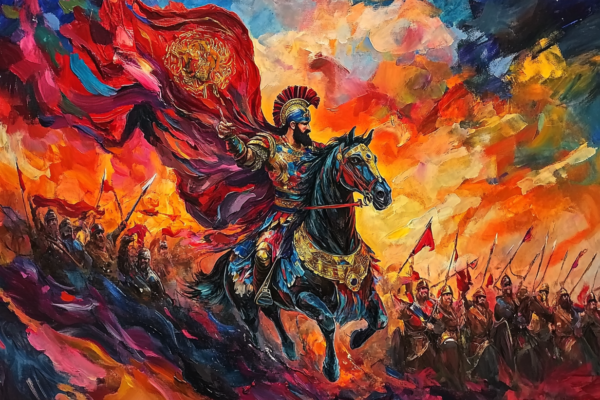The Early Life of Arsaces I
Born on the boundless steppes of the ancient world, Arsaces I would become the leader who would one day establish a great state. The region where Arsaces I was born corresponds to today’s vast steppes around modern-day Turkmenistan. These lands were home to fiercely independent nomadic peoples, skilled in riding swift horses and fighting on the move. Arsaces I grew up in this harsh environment; courage, endurance, and martial prowess became inseparable parts of his character.
Arsaces I was one of the prominent leaders of the Parni tribe, a branch of the Dahae confederation. From a young age, he emerged as a significant figure within his tribe through his military talents and political intuition. Sources mention that Arsaces I had a brother or a close relative who moved alongside him, often identified as Tiridates. However, over time, Arsaces I fully assumed leadership within this partnership. His vision extended beyond leading a nomadic people; he sought to build a permanent and structured state.
At this time, the Seleucid Empire was beginning to lose control, particularly over its eastern borders. In the region of Parthia, the local satrap Andragoras began displaying tendencies toward independence. However, weakened authority and lack of support made Parthia an open target for invasion. Reading the situation astutely, Arsaces I boldly led his tribe into action.
![Coin of Arsaces I. The reverse shows a seated archer carrying a bow, with the Greek legend reading "ΑΡΣΑΚΟΥ" (right) and "[AYT]OKPATOP[OΣ]" (left), meaning [coin of] "Arsaces"](https://historifyproduction.com/wp-content/uploads/2025/04/500px-Coin_of_Arsaces_I_1_Nisa-1.png)
Coin of Arsaces I. The reverse shows a seated archer carrying a bow, with the Greek legend reading “ΑΡΣΑΚΟΥ” (right) and “[AYT]OKPATOP[OΣ]” (left), meaning [coin of] “Arsaces”
Classical Numismatic Group, Inc. http://www.cngcoins.com, Coin of Arsaces I (1), Nisa mint, CC BY-SA 3.0
Arsaces I proved to be one of the leaders who best understood the spirit of the era. As the head of the Parni people within the Dahae confederation, he distinguished himself at a young age through his martial abilities, political acumen, and charismatic leadership. Although the Parni people maintained a nomadic lifestyle, they possessed an excellent military organization; their swift cavalry, archers, and light horsemen embodied the free spirit of the steppe. Yet Arsaces I’s vision went beyond mere military prowess: he aimed to unite his people under the framework of a settled, enduring state.
Meanwhile, Andragoras, the satrap of Parthia, had effectively broken away from the Seleucid Empire. However, this declaration of independence left him isolated and vulnerable to attacks. Seizing the opportunity, Arsaces I gathered his Parni warriors and launched a daring campaign toward Parthia around 247 BCE.
The campaign was not merely a military operation; it was a people’s march toward destiny. The Parni army moved with lightning speed, capturing the strategic centers of Parthia. Andragoras could not resist Arsaces I’s tactical brilliance and the popular support behind him. After a short resistance, he was defeated, and control of Parthia passed entirely into the hands of Arsaces I.
However, victory meant more than the conquest of land. In Parthia, Arsaces I became the architect of a transition from nomadic warrior culture to structured state-building. New settlements were founded, old cities were restored. Local traditions, Persian administrative practices, and tribal bonds were blended together to create a flexible yet strong governing model. Each region was granted wide autonomy, but above all stood the unchallenged authority of Arsaces I.

Location of Parthia and its surroundings.
The Founding of the Parthian State
A major symbolic step was also taken. Arsaces I did not define himself merely as a king, but as the new legitimate sovereign of Iran. By adhering to the traditions of the ancient Achaemenid dynasty, he positioned himself in the eyes of the people as the new protector of Persian cultural heritage. For this reason, all subsequent Parthian kings used the name “Arsaces” as an honorary title, remaining loyal to their origins. Over time, the name of Arsaces I came to symbolize not just an individual, but an entire dynasty and a longstanding state tradition.
After achieving his initial conquests, Arsaces I understood very well that it was vital to establish lasting power over the territories he had seized. Therefore, he did not content himself with merely capturing land; he focused his primary efforts on consolidating his authority and transforming the new Parthian state into a permanent and stable force. The steps he took during this period laid the foundation for the enduring success of the Parthian Empire in the centuries that followed.
First, he undertook the fortification of Parthia’s castles and strategic centers. Existing defensive structures were repaired and new ones were built. Especially in the northeastern regions of the Iranian plateau, critical mountain passes and key strongholds were reinforced, forming a defensive network that served as a physical guarantee of Arsaces I’s rule against both external invasions and potential internal rebellions.
.
Family Tree of Arsaces I
Unknown Ancestors
│
Arsaces I
│
(Brother) Tiridates
│
(Son or Nephew) Arsaces II
│
Artabanus I
│
Priapatius (Phriapatius)
│
Phraates I → Mithridates I
│
Phraates II
│
Artabanus II
Yet Arsaces I did not rely solely on military measures. He also established a localized administrative system. In contrast to the heavily centralized structure of the Seleucids, he adopted a more flexible model based on local powers. As a result, different tribes and cities within the Parthian realm were able to manage their internal affairs with a significant degree of autonomy while pledging loyalty to Arsaces I in broader political matters. This approach, particularly among nomadic and semi-nomadic groups, garnered substantial support.
Another crucial aspect of Arsaces I’s success was his political diplomacy. He extended his superiority beyond the battlefield, negotiating agreements with leaders of various ethnic and cultural groups, forming alliances, and allowing these communities to maintain their own traditions. This pragmatic and inclusive strategy enabled him to integrate both Persian-origin populations and nomadic groups into the state’s administrative fabric.
Particularly noteworthy was that Arsaces I did not impose a harsh policy of forced assimilation on the newly conquered peoples. On the contrary, by respecting and supporting local cultures and customs, he earned the voluntary loyalty of diverse communities. In this way, the Parthian state quickly evolved into a culturally rich and multilayered structure. A model was created in which various peoples lived together while recognizing a single political authority at the top — and this model would become one of the most important reasons for the long-term survival of the Parthian Empire.
The Economic Vision of Arsaces I
After founding the Parthian state, Arsaces I took critical steps not only to consolidate political and military power but also to strengthen economic stability. Chief among these initiatives was the decision to mint coins bearing his own name — a move that would enter history as a crucial strategy, symbolizing both the independence of his rule and the legitimacy of the newly established state.
In the eastern provinces of the Seleucid Empire, Seleucid-style coins were still in circulation. However, to solidify Parthia’s independence, Arsaces I had new coins minted featuring his own name and distinct designs. These coins sent a clear message to both domestic and foreign audiences: Parthia was no longer a province of the Seleucids, but a sovereign kingdom.
The earliest coins minted under Arsaces I initially resembled the style of Seleucid coinage. The obverse typically displayed portraits of kings designed with traditional Hellenistic artistic influence. However, over time, unique Parthian elements began to appear more prominently in Arsaces I’s coinage. The royal figures depicted started to carry more local and Iranian features — warriors portrayed with a bow in hand or wearing traditional Parthian attire became common motifs.
On the reverse side of these coins, inscriptions often appeared in a Hellenistic Greek style. The inscriptions clearly stated the name “Arsaces” along with the royal title, thereby maintaining some alignment with the monetary conventions of the Hellenistic world, while also affirming that Parthian sovereignty was exercised under Arsaces’s authority. These inscriptions demonstrated that while the Parthian state continued to engage economically and diplomatically with the broader Hellenistic world, it firmly maintained its principle of independence.
Arsaces I’s coinage policy was not merely a tool of prestige; it was a calculated economic reform aimed at establishing financial stability. Minting his own currency allowed the young state to efficiently collect taxes, pay its armies, and control key trade routes. Particularly in regions near the Silk Road, these coins entered wide circulation and significantly contributed to the vitality of the Parthian economy.


![Coin of Arsaces I. The reverse shows a seated archer carrying a bow, with the Greek legend reading "ΑΡΣΑΚΟΥ" (right) and "[AYT]OKPATOP[OΣ]" (left), meaning [coin of] "Arsaces"](https://historifyproduction.com/wp-content/uploads/2025/04/500px-Coin_of_Arsaces_I_1_Nisa-1-150x150.png)


